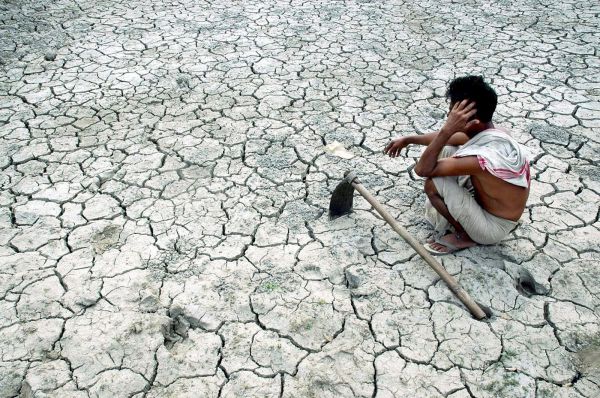Vidarbha Reels Under Agrarian Distress

NEW DELHI: The policies that have greatly aggravated the agrarian crisis and peasant indebtedness include reversal of land reforms in order to give large tracts of land to corporates, slashing of subsidies on all agricultural inputs like fertilizers and diesel, removal of quantitative restrictions on foreign agricultural imports. Other factors include decline in public expenditure on agriculture, irrigation and rural development, invasion of MNCs in agriculture, leading to big rise in costs of all inputs, privatization of irrigation and power projects, leading to much higher costs, crunch in institutional credit to farmers, thus boosting rapacious money-lenders. There has also been serious weakening of agricultural research and development and extension systems.
In order to prevent farmers suicide in the state, Maharashtra Government is planning to implement zero farmers suicide welfare program called ‘convergence of agriculture intervention in agriculture’ in the state. Agriculture Minister Eknath Khadse said that under the scheme a survey would be undertaken in all suicide prone farming regions like Vidarbha, Marathawada and North Maharashtra.
Yet farmers die by the dozen in Vidarbha every week. Till September 2010, there had been 654 suicides in the region. That is, every 13 hours a farmer commits suicide. “This is the official number. The deaths not recorded as suicides by the police would be another 250-300”, said Prakash Pohare, an activist-journalist in Akola.
Everybody knows why farmers commit suicide: debt trap due to crop loss or poor crop prices. So why can’t the government fix it? Faulty and skewed policies, in fact, are at the bottom of the farmers’ suicide story.
Farmers’ input costs have shot up and the returns seldom match them. “The input or production costs in cotton farming with chemical fertilisers, pesticides and Bt cotton have increased 10 times in the last 10 years but the returns are dropping every year,” said Gopal Shelke, a cotton farmer in Kanheri in Akola. In fact, all the farmers cultivating Bt cotton in his village are in the debt trap.
Though the worst affected by the debt trap and suicides, Vidarbha is the least benefited from the government’s loan waiver. The properties of the joint families in the region are often in the name of all the family members (unlike elsewhere in the state where the family-owned land is divided in the names of individual members and every individual has the status of an independent farmer) making them ineligible for the loan waiver which requires a farmer to hold not more than five acres.
Even for many of the farmers who got the loan waiver, the benefit was restricted to Rs:25,000 and the balance amounts were just rescheduled. Since 2001, as per official data, six of eleven districts of Vidarbha—Amaravati, Akola, Yavatmal, Buldhana, Washim and Wardha—had more than 8,000 farmer suicides but only 2,497 of them have been “eligible for the compensation of Rs:1 lakh. Every year the percentage of ineligible farmers is increasing because of the wrong and faulty panchanamas done by the police and this happens at the behest of the government.
The core problems like rising production costs, falling prices, reducing productivity, food security and efficient crop insurance remain to be addressed. Through his Vidarbha Janaandolan Samiti, Kishore Tiwari has been working on the agrarian crisis in Vidarbha for long. “The most feasible solution to this problem is to immediately opt for organic farming. It is the most cost-effective way of increasing productivity in terms of number as well as nutrition quality,” he said. He suspects a conspiracy behind the government promoting hybrid seeds and chemical fertilisers which are harming farmers.
Bt cotton seeds promoted by the state have increased the economic pressure on farmers instead of resulting in higher yields of disease free crops. Already a low return and high risk livelihood, these policies that claim to reduce the risk have only increased the cost of farming. As a result, the cotton economy of the region has collapsed, resulting in mass suicide since 2001. When the rate of cotton lint gets a rate of $5.346 per kg in USA (around Rs 8,906 per quintal), the farmers of Vidarbha was getting a meager rate of Rs 4,000 per quintal.
Looking at prevailing situation internationally wherein cotton prices are likely to soar to Rs 7,000 a quintal this year too riding on the global scarcity on account of poor crops in the US, China and Pakistan, Indian cotton farmers can hedge these prices only if central Govt. manages to raise the minimum support price to Rs 6,000 level but The government has not responded favorably disappointing cotton farmer hence we urge for urgent intervention to save dying cotton farmers.
About 90 per cent of the farmers in Vidarbha do not have access to institutional loans and go to private moneylenders, who charge 48 per cent to 60 per cent interest. If the government is serious about helping the farmers of Vidarbha, experts say, it should get rid of the administrative negligence and take appropriate measures to plug the gaps in the system. It should proactively and empathetically look at their problems. Until then the number of widows in Vidarbha will keep rising. All these factors have led to failures of the welfare schemes. They have not succeeded and the cotton farmers in Vidarbha still continue to commit suicide.
(The writer is a doctoral student at Jawaharlal Nehru University).
(Cover photo: Milaap.org)



